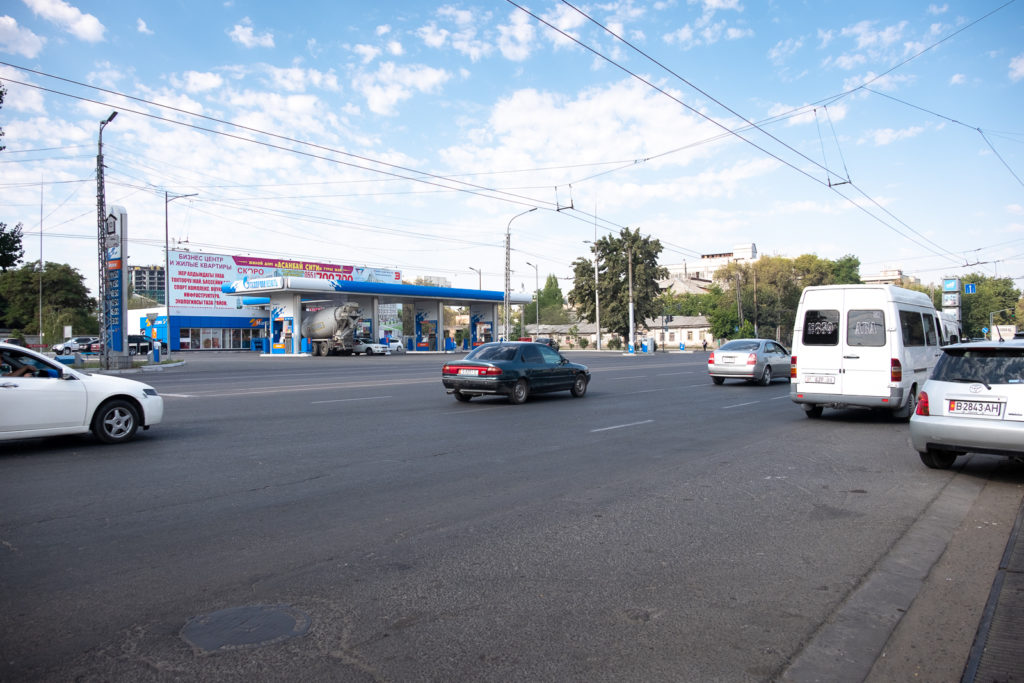Spending a month hanging out in Bishkek has allowed me to do several walking tours with the amazing Rahat of Bishkek Walks. I loved her unusual ideas of building a walking tour about a very specific aspect of Bishkek History (the Interhelpo: The making of industrial Bishkek tour), and exploring the history of Bishkek and Kyrgyzstan through artwork (Mosaic Walking tour). So to end my stay I also joined her once more for her History of Bishkek tour.

Victory Square
The tour began in Victory Square. This location used to be the central market of Bishkek, but has now been turned into a plaza with the Monument of Victory at its centre. The monument itself was finished in 1985 to commemorate the 40th anniversary of the end of the Second World War, and features a woman waiting for loved ones to return home from battle.

She is positioned facing North (the direction in which the men went off to fight) under 3 granite half-arches that represent the supports of a yurt (a traditional Kyrgyz nomad tent). The crown (the ring where the supports come together) is in the shape of a wreath with the Soviet star inside. The eternal flame sits at her feet.

The Silk Road
As we gathered in the shade under the arches of the monument, Rahat told us about the ancient history of Kyrgyzstan and its nomadic tribes. She then led us over the Northern branch of the ancient Silk Road heading towards our next stop.
Yes – the Silk Road looks a little less romantic these days…

Blacksmith’s Fortress
We walked along a dirt road between slightly dodgy looking houses to arrive at something you would never find for yourself if you weren’t on a guided tour. The Кузнечная крепость – or Blacksmith’s Fortress.

Drag to see the entire panorama
While there is no longer all that much to see beyond a few mounds indicating foundations of structures (the original buildings were made of mud), Rahat had a wealth of information about the site and its importance in Kyrgyzstan. While the last ruin was that of a Kokhand fortress built in 1825, the site has multiple layers of history, reaching back to ancient times.
Walking towards our next major stop, Rahat talked a lot about the evolution of languages in Kyrgyzstan, the origin of Bishkek’s parks, and we even stopped off to try the traditional drink – Shoro – sold by a street vendor. She really is the most incredibly knowledgeable person and we had a great group that asked loads of questions!

Mikhail Frunze Museum
Did you know that Bishkek was called Frunze for a period of time?
The story of how this came to be was the next piece to fall into place in the History of Bishkek walking tour.

Frunze, it turned out, was a celebrated Bolshevik General and a close associate of Lenin. To honor his death (itself an interesting story), the Soviets renamed his home town of Bishkek to be Frunze – a name that it kept throughout the Russian era. It was only renamed to Bishkek in 1991 when Kyrgyzstan re-gained independence from the Soviet Union.
Although we didn’t go inside the museum, it occupies the building where Frunze’s father provided medical services (the house he grew up in was destroyed) and apparently documents his life and military exploits, as well as Kyrgyzstan’s accomplishments both before and after the Soviet era.
Lenin Memorial
Our next major stop was the Lenin Monument. Originally occupying pride of place in the centre of Ala-Too Square (then called Lenin Square), it was moved around the back of the National History museum to this park in 2003.

Where many Lenin statues were torn down and/or destroyed after the ex-USSR states achieved their independence from the Soviet Union, Bishkek’s Lenin enjoyed a more generous fate. The Kyrgyz people still recognise the positive aspects of communism and socialism (equality, good health care, free education system, etc) and wanted to preserve that part of their history. This monument is thought to be the last major statue of Lenin standing in all of Central Asia.
Ala-Too Square
The final location of the tour was the impressive Ala-Too Square. This enormous space is backed by the beautiful National History Museum building (which has unfortunately been closed for renovations for the past 3 years!), and is used for all major National events. For example, it was the site of the largest anti-government protest during Kyrgyzstan’s Tulip Revolution in 2005.

Lenin used to occupy pride of place here, but in 2003 his statue was moved around the back and replaced by the controversial Freedom statue (Erkindik), which in turn was replaced in 2011 by the current statue of Manas – the national hero of Kyrgyzstan and someone universally loved by the Kyrgyz people.

Recommendation
The History of Bishkek walking tour with Bishkek Walks is the absolute best way to learn about the city and Kyrgyzstan in general. I haven’t covered even a fraction of all the things Rahat told us about in the above – she is a truly amazing wealth of stories and information.
If you are interested in learning about the history of Kyrgyzstan, you absolutely must do this tour! You won’t find a better or more knowledgeable guide than Rahat.
Time: 2 – 3 hours
Cost: About USD$10 – $22 depending on number of people.
